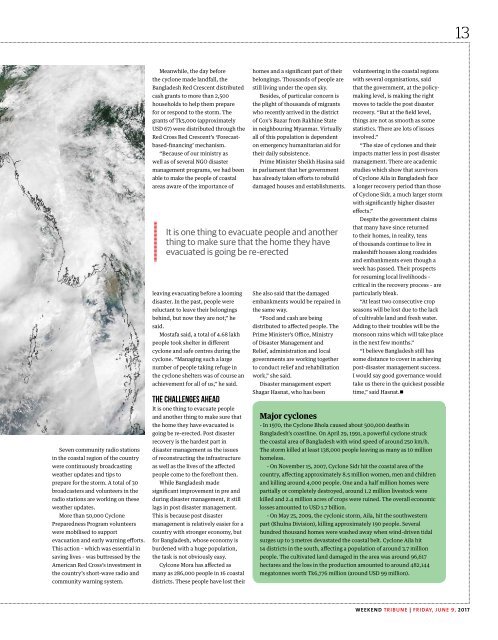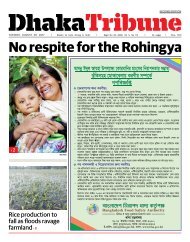Weekend-5-8
You also want an ePaper? Increase the reach of your titles
YUMPU automatically turns print PDFs into web optimized ePapers that Google loves.
13<br />
Seven community radio stations<br />
in the coastal region of the country<br />
were continuously broadcasting<br />
weather updates and tips to<br />
prepare for the storm. A total of 30<br />
broadcasters and volunteers in the<br />
radio stations are working on these<br />
weather updates.<br />
More than 50,000 Cyclone<br />
Preparedness Program volunteers<br />
were mobilised to support<br />
evacuation and early warning efforts.<br />
This action – which was essential in<br />
saving lives – was buttressed by the<br />
American Red Cross’s investment in<br />
the country’s short-wave radio and<br />
community warning system.<br />
Meanwhile, the day before<br />
the cyclone made landfall, the<br />
Bangladesh Red Crescent distributed<br />
cash grants to more than 2,500<br />
households to help them prepare<br />
for or respond to the storm. The<br />
grants of Tk5,000 (approximately<br />
USD 67) were distributed through the<br />
Red Cross Red Crescent’s ‘Forecastbased-financing’<br />
mechanism.<br />
“Because of our ministry as<br />
well as of several NGO disaster<br />
management programs, we had been<br />
able to make the people of coastal<br />
areas aware of the importance of<br />
leaving evacuating before a looming<br />
disaster. In the past, people were<br />
reluctant to leave their belongings<br />
behind, but now they are not,” he<br />
said.<br />
Mostafa said, a total of 4.68 lakh<br />
people took shelter in different<br />
cyclone and safe centres during the<br />
cyclone. “Managing such a large<br />
number of people taking refuge in<br />
the cyclone shelters was of course an<br />
achievement for all of us,” he said.<br />
The challenges ahead<br />
It is one thing to evacuate people<br />
and another thing to make sure that<br />
the home they have evacuated is<br />
going be re-erected. Post disaster<br />
recovery is the hardest part in<br />
disaster management as the issues<br />
of reconstructing the infrastructure<br />
as well as the lives of the affected<br />
people come to the forefront then.<br />
While Bangladesh made<br />
significant improvement in pre and<br />
during disaster management, it still<br />
lags in post disaster management.<br />
This is because post disaster<br />
management is relatively easier for a<br />
country with stronger economy, but<br />
for Bangladesh, whose economy is<br />
burdened with a huge population,<br />
the task is not obviously easy.<br />
Cylcone Mora has affected as<br />
many as 286,000 people in 16 coastal<br />
districts. These people have lost their<br />
homes and a significant part of their<br />
belongings. Thousands of people are<br />
still living under the open sky.<br />
Besides, of particular concern is<br />
the plight of thousands of migrants<br />
who recently arrived in the district<br />
of Cox’s Bazar from Rakhine State<br />
in neighbouring Myanmar. Virtually<br />
all of this population is dependent<br />
on emergency humanitarian aid for<br />
their daily subsistence.<br />
Prime Minister Sheikh Hasina said<br />
in parliament that her government<br />
has already taken efforts to rebuild<br />
damaged houses and establishments.<br />
It is one thing to evacuate people and another<br />
thing to make sure that the home they have<br />
evacuated is going be re-erected<br />
She also said that the damaged<br />
embankments would be repaired in<br />
the same way.<br />
“Food and cash are being<br />
distributed to affected people. The<br />
Prime Minister’s Office, Ministry<br />
of Disaster Management and<br />
Relief, administration and local<br />
governments are working together<br />
to conduct relief and rehabilitation<br />
work,” she said.<br />
Disaster management expert<br />
Shagar Hasnat, who has been<br />
volunteering in the coastal regions<br />
with several organisations, said<br />
that the government, at the policymaking<br />
level, is making the right<br />
moves to tackle the post disaster<br />
recovery. “But at the field level,<br />
things are not as smooth as some<br />
statistics. There are lots of issues<br />
involved.”<br />
“The size of cyclones and their<br />
impacts matter less in post disaster<br />
management. There are academic<br />
studies which show that survivors<br />
of Cyclone Aila in Bangladesh face<br />
a longer recovery period than those<br />
of Cyclone Sidr, a much larger storm<br />
with significantly higher disaster<br />
effects.”<br />
Despite the government claims<br />
that many have since returned<br />
to their homes, in reality, tens<br />
of thousands continue to live in<br />
makeshift houses along roadsides<br />
and embankments even though a<br />
week has passed. Their prospects<br />
for resuming local livelihoods –<br />
critical in the recovery process – are<br />
particularly bleak.<br />
“At least two consecutive crop<br />
seasons will be lost due to the lack<br />
of cultivable land and fresh water.<br />
Adding to their troubles will be the<br />
monsoon rains which will take place<br />
in the next few months.”<br />
“I believe Bangladesh still has<br />
some distance to cover in achieving<br />
post-disaster management success.<br />
I would say good governance would<br />
take us there in the quickest possible<br />
time,” said Hasnat.•<br />
Major cyclones<br />
- In 1970, the Cyclone Bhola caused about 500,000 deaths in<br />
Bangladesh’s coastline. On April 29, 1991, a powerful cyclone struck<br />
the coastal area of Bangladesh with wind speed of around 250 km/h.<br />
The storm killed at least 138,000 people leaving as many as 10 million<br />
homeless.<br />
- On November 15, 2007, Cyclone Sidr hit the coastal area of the<br />
country, affecting approximately 8.5 million women, men and children<br />
and killing around 4,000 people. One and a half million homes were<br />
partially or completely destroyed, around 1.2 million livestock were<br />
killed and 2.4 million acres of crops were ruined. The overall economic<br />
losses amounted to USD 1.7 billion.<br />
- On May 25, 2009, the cyclonic storm, Aila, hit the southwestern<br />
part (Khulna Division), killing approximately 190 people. Several<br />
hundred thousand homes were washed away when wind-driven tidal<br />
surges up to 3 metres devastated the coastal belt. Cyclone Aila hit<br />
14 districts in the south, affecting a population of around 3.7 million<br />
people. The cultivated land damaged in the area was around 96,617<br />
hectares and the loss in the production amounted to around 482,144<br />
megatonnes worth Tk6,776 million (around USD 99 million).<br />
WEEKEND TRIBUNE | FRIDAY, JUNE 9, 2017


















